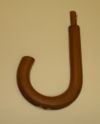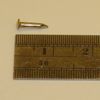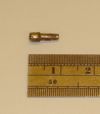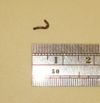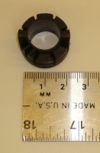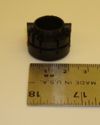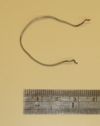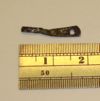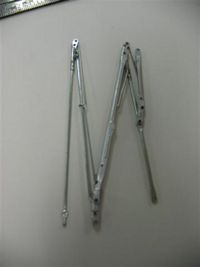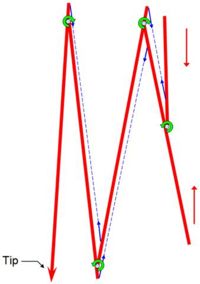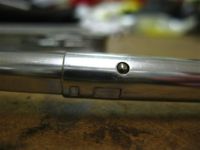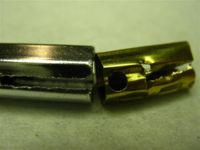Umbrella
From DDL Wiki
(→DFE) |
(→DFE) |
||
| Line 93: | Line 93: | ||
Main Materials Used and Comments | Main Materials Used and Comments | ||
* Wood (treated) | * Wood (treated) | ||
| - | + | ** Natural wood is bio-degradable, however this wood appears laminated and chemically treated/coated to produce a desirable surface finish, which will likely impede degradation | |
| - | + | ** Due to lamination process, it is unlikely that return these products to the manufacturer would result in recycling of materials. | |
* Plastic (Thermoplastic) | * Plastic (Thermoplastic) | ||
| - | + | ** Thermoplastics can be recycled if returned to the manufacturer | |
| - | + | ** Does not appear to be made of out of commonly recycled materials, so recycling on a large scale may be impeded. | |
| - | + | ** Non-Biodegradable | |
* Steel | * Steel | ||
| - | + | ** Non-Biodegradable | |
| - | + | ** Stamping process used to create the piece is lower energy compared to other forming techniques | |
Revision as of 19:58, 21 September 2008
Contents |
Umbrella
Basic introduction information. 'Contents' box is created automatically. To skip directly to a section, use Umbrella#FMEA to create a link.
Usage and Usability
An umbrella's primary purpose is to protect the user from rain, although they are also used in some cases to protect against sun or snow. To do this, an umbrella has a long, slender shaft with a handle on one end and a collapsible canopy on the other, coming to a point at the umbrella's tip.
The umbrella's protective canopy is extended as a rider, initially located near the handle, travels up the shaft towards the tip. In a standard non-collapsible umbrella such as ours, the rider's motion is started by releasing the rider latch on the handle end of the shaft and manually moving the rider upwards until the rider engages a second latch on the tip end of the shaft, locking the rider and canopy in place.
Some improvements on the standard umbrella design have been made to overcome some of the standard umbrella's flaws.
The rider mechanism in many umbrellas, such as the golf umbrella, is spring loaded to provide one-handed automatic opening. This is an improvement over the two-handed opening that the standard umbrella offers. The canopy must be forced closed and the spring must be manually reset after use.
Because an umbrella has a very specific intended usage - outside during rain - there are times when the umbrella will not be in use but must be carried for later use, such as indoors. It is beneficial to the user for the umbrella to be lightweight and have a small footprint when not in use. One popular variation on the standard umbrella is the purse umbrella. This umbrella has a hollow telescoping shaft that extends with a button press as the spring-loaded canopy is extended. The footprint of the umbrella and its weight are reduced substantially, enough that the umbrella fits conveniently into a purse or backpack and can be carried at all times. This decrease in size comes with an increase in component complexity, as the shaft cannot be a single piece of material and the arms must be folded as well. Additional joints are needed, and the overall strength of the umbrella is reduced. Like the golf umbrella, the purse umbrella must be manually closed to reset the spring.
The most complex variant on the classic umbrella is an automatically opening and closing umbrella. This extends the functionality of the purse umbrella by using an additional mechanism to automatically close the canopy with a button press. While the canopy is automatically closed, the spring must still be manually reset.
Even with these improvements over the standard umbrella, some issues remain unaddressed. All of the umbrellas designed for personal use must be carried by hand, and even the most complex umbrellas must be forced closed manually after use. This can be a difficult task for people with motor disabilities, such as Parkinson's disease.
Parts List
Major Stakeholders and Needs
DFA
Umbrellas are a high production part and as a result a great deal of effort has been put into design for assembly. With respect to assembly, the umbrella is broken into three sub assembles: the shaft, the arms and the canopy. By breaking it into these individual sub sections this arms can be assembled independently of the shaft which can be assembled independently of the canopy, saving assembly time. Design for assembly has been considered within each sub assembly by designing the joints and parts such that there are generous tolerances with respect to part location and by designing the joints such that they are easy to make. With respect to the arms, all of the joints except that connecting the Arm Support Rod to the Arm Joint Connector are crimped connectors to reduce assembly time and part count. Additionally, all of the 8 umbrella arms are identical which improves the ease of assembly and reduces the part count of the umbrella. With respect to the shaft, design for assembly has been considered in the use of identical components for the Upper and Lower Rider Latches. Making these components identical prevents confusion during assembly and the parts are designed such that they are simply hammered onto the shaft to reduce assembly time. Also, assembly tolerances were considered with respect to attaching the Handle to the Shaft. While glue is required for this joint, there is a large tolerance with respect to how deep the shaft has to be placed inside the handle, reducing the time that is required to assembly this joint. Along with being easy to assemble individually, the umbrella sections are designed to be easy to assemble to one another, with the arms attaching to the shaft using two pieces of wire. This attachment method makes it easy for the umbrella to be assembled quickly and simply.
DFM
In order to reduce the manufacturing cost and effort the individual components of the umbrella have been designed with Design for Manufacture in mind. The majority of the metal parts on the umbrella are made through stamping premanufactured flat or round stock into the desired shape. This process is fast, efficient and removes the need for time intensive machining thereby dramatically reducing the associated manufacturing costs. Additionally by replicating components such as the Rider Latches and the arm components manufacturing costs are reduced. Similarly all of the plastic parts on the umbrella are injection molded for quick manufacturing time and reduced material cost. The umbrella also uses “off the shelf” fasteners where possible such as in attaching the top cap and upper hub to the shaft. Both of the fasteners involved in this assembly are standard brad nails which, because they do not need to be manufactured, reduce the cost of manufacturing the umbrella.
Here's an external link.
Here's an external link to a Excel to Wiki converter.
Here's the Wikipedia editing page. DDWiki and Wikipedia both run on MediaWiki software.
Here's an internal link back to the Main_Page. Using piping | lets you rename a link to, for example, the main page.
If you don't want something formatted, try using these HTML tags. Then you can put things like [[Main_Page]] into the document.
DFE
The choices made in the design and manufacture of a standard umbrella have a variety of environment consequences. Since there are a large variety of umbrella designs, these issues may be different depending on the model and manufacturer. These comments pertain only the standard umbrella that we studied. Main Materials Used and Comments
- Wood (treated)
- Natural wood is bio-degradable, however this wood appears laminated and chemically treated/coated to produce a desirable surface finish, which will likely impede degradation
- Due to lamination process, it is unlikely that return these products to the manufacturer would result in recycling of materials.
- Plastic (Thermoplastic)
- Thermoplastics can be recycled if returned to the manufacturer
- Does not appear to be made of out of commonly recycled materials, so recycling on a large scale may be impeded.
- Non-Biodegradable
- Steel
- Non-Biodegradable
- Stamping process used to create the piece is lower energy compared to other forming techniques
EIO-LCA
This is for the EIO-LCA subsection of DFE.
FMEA
This below table lists the results of our Failure Modes and Effects Analysis, followed by a brief summary of the major issues that we viewed as the most important. Only components with an RPM greater than 40 were given corrective action. The top 5 RPN components have been bolded.
| Item or Function | Failure Mode | Effects of Failure | S | Causes of Failure | O | Design Controls | D | RPN | Recommended Actions | Responsibility |
| Shaft | Splintering | Decreased shaft strength | 5 | Wear | 3 | Coating or finish on shaft | 4 | 60 | Revised Design/Material Selection | Engineering Design |
| Potential safety hazard to user | Material choice | |||||||||
| Durability testing | ||||||||||
| Breakage | Product is inoperable | 8 | Inappropriate stresses on shaft | 1 | Material Quality | 5 | 40 | NONE | NONE | |
| Impact | Robust Design | |||||||||
| Rot | Reduced Strength | 3 | Poor Protective Coating | 1 | Coating Process Control | 5 | 15 | NONE | NONE | |
| Handle | Splintering | Decreased handle strength | 7 | Wear | 4 | Coating or finish on handle | 4 | 112 | Revised Design/Material Selection | Engineering Design |
| Potential safety hazard to user | Material choice | |||||||||
| Durability testing | ||||||||||
| Breakage | Product is inoperable | 7 | Impact | 1 | Material Quality | 5 | 35 | NONE | NONE | |
| Robust Design | ||||||||||
| Rot | Reduced Strength | 3 | Poor Protective Coating | 1 | Coating Process Control | 5 | 15 | NONE | NONE | |
| Tip | Loss of Protection | Degredation of Shaft | 2 | Wear | 4 | Material choice | 7 | 56 | Revised Material Selection | Engineering Design |
| Part Design | ||||||||||
| Top Cap | Corrosion | Decrease In Aesthetics | 2 | Oxidation | 2 | Material choice/Coating | 5 | 20 | NONE | NONE |
| Rider Latch | Bending | Latch fails to operate | 8 | Inappropriate Loading | 1 | Part Design | 2 | 16 | NONE | NONE |
| Jamming | Latch fails to operate | 8 | Corrosion/Foreign Debris/Poor Assembly | 2 | Tolerance control | 4 | 64 | Improved Quality Control in Assembly | Manufacturing | |
| Rider Latch Pin | Loss | Potential Loss of Latch | 5 | Vibration/Poor Assembly | 1 | Proper Assembly | 2 | 10 | NONE | NONE |
| Canopy section | Tear | Leak in Umbrella | 7 | Improper Manufacturing/Improper Storage by Consumer | 5 | Material Selection/Manufacturing Control | 4 | 140 | Improved Quality Control | Product Manufacturing |
| Seam Failure | Leak in Umbrella | 7 | Improper Manufacturing | 3 | Manufacturing Controls | 6 | 126 | Improved Quality Control | Manufacturing | |
| Canopy Latch Strap | Seam Failure | Inability to strap umbrella | 5 | Improper Manufacturing | 3 | Manufacturing Controls | 6 | 90 | Improved Quality Control | Manufacturing |
| Hub Pin | Loss | Upper Hub not longer attached to shaft | 8 | Improper Tolerancing/Manufacturing | 1 | Proper Tolerancing/Manufacturing | 2 | 16 | NONE | NONE |
| Connecting wire | Breakage | Arms disconnect from shaft | 8 | Wear | 1 | Coating/Material Selection | 6 | 48 | Revised Design | Engineering Design |
| Rider | Button Breakage | Latch more difficult to operate | 6 | Fatigue | 2 | Proper Tolerancing/Manufacturing | 3 | 36 | NONE | NONE |
| Arm Mainshaft | Plastic Yielding | Deformed umbrella shape/trouble closing | 7 | Excessive Loading | 6 | Part Design/Material Selection | 4 | 168 | Revised Design | Engineering Design |
| Arm Support Rod | Plastic Yielding | Deformed umbrella shape/trouble closing | 8 | Excessive Loading/Impact | 6 | Part Design/Material Selection/Manufacturing | 4 | 192 | Revised Design | Engineering Design |
| Arm Endcap | Disassociation from Arm | Partial Canopy Detatchment/Exposed Rod | 7 | Insufficient Crimping/Tolerances | 5 | Manufacturing and Assembly Controls | 3 | 105 | Revised Manufacturing Specification | Engineering Design |
| Short string | Snap | Partial Canopy Detatchment | 7 | Excessive Loading/Defective Materials/Poor Manufacturing | 3 | Material Quality/Manufacturing | 5 | 105 | Improved Quality Control | Manufacturing |
| Arm Joint Connector | Plastic Yielding | Non-smooth operation | 2 | Excessive Loading | 2 | Part Design/Material Selection/Manufacturing | 2 | 8 | NONE | NONE |
| Seperation from Arm | Impaired operation of umbrella | 8 | Improper Manufacturing | 3 | Manufacturing and Assembly Controls | 3 | 72 | Improve Quality Control in Assembly | Manufacturing |
Summary
The main issues seen in the FMEA deal primarily with three issues:
- Plastic Deformation of the umbrella arms
- Poor Canopy Quality
- Handle Degradation
The plastic deformation of the umbrella arms is primarily a design issue. By having a better understanding of the kind of loads that are applied to the umbrella, engineering design can redesign the arms to be more robust against yielding issues. This could mean improving the strength of the arms or, conversely, making them more flexible to allowing for more deformation before yield.
Poor canopy quality is primarily a function of the quality of the materials and the manufacturing process. By reducing variation in the quality of unprocessed fabric materials in the supply chain, this issue will be greatly reduced. It is also the job of the Manufacturing department to ensure that the machines used to process the fabric are not detrimental or add variation to the final quality of the product. There should also exist some form of quality control before the product leaves the factory in order to ensure the integrity of the woven materials.
Handle degradation is another design issue. By choosing wood as a material, the designers introduced the associated failure modes. By changing the material selection to account for a plastic or metal handle, the designers could have avoided the potential splintering of wood, and might even have been able to reduce the cost of the product. For mass production parts such as umbrellas, the tooling costs for plastic parts would not be cost prohibitive.
Here's a horizontal line
And another
They come free with section headings
Mechanical Analysis
Design Variants
Golf Umbrella
Golf Umbrella makes a big difference by having double layered canopies (upper and bottom) to avoid umbrella to fail by wind. To accomplish this purpose, wind blows under the umbrella and go out of the canopy through the gaps between outer and inner canopies. Each arm of the umbrella has canopy hook to attach the bottom canopy to the arms. Possible failure could occur from this part when too much force applied on the canopy hook. The upper canopy attaches itself on side arms extended and bent in the counter-clockwise direction from the main arms. The size of the golf umbrella is relatively bigger than regular umbrella and it has a big spring with strong stiffness on the rider to keep the umbrella opened. The shaft of the umbrella was made of carbon fiber and hollow, so that it can reduce the total weight of the umbrella compared to an umbrella with solid shaft. However, the shaft might emit harmful material when it is destroyed since it is made of carbon fiber.
